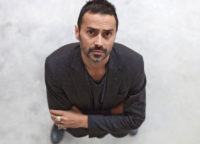The relationship between architecture and dance—the art of creating spaces and the art of navigating spaces—is fertile territory. Previous explorations have included Isamu Noguchi’s highly architectural sets for Martha Graham, and Merce Cunningham’s performances at Philip Johnson’s Glass House.
Now Steven Holl, whose architectural forms can be as fluid as a dancer’s limbs, has collaborated with the Jessica Lang Dance Company on a 20-minute piece called Tesseracts of Time. Commissioned by the Chicago Architecture Biennial, it debuted at Chicago’s Harris Theater November 6. It will be performed at the Joyce Theater in New York in April, though on a smaller stage.
Holl and choreographer Lang used the proscenium stage of the Harris Theater (beneath Millennium Park) to explore four ways buildings can relate to the ground—under it, in it, on it, and over it—with each inspiring one part of their four-act composition.
For the first two acts, the sets consist of images of architectural models, photographed in extreme close-up and projected on a screen. Initially, the images serve as mere backdrops. But later, with the screen lowered to the stage, the dancers appear to move through the models, a startling effect accomplished by shooting the performers against green screens and then overlaying those videos against images of the models. Other members of the Lang company dance in front of the projections, creating productive confusion between the real and the illusory.
These architectural models were created in Holl’s studio, under the supervision of project architect Dimitra Tsachrelia, as part of an ongoing investigation of complex forms, including mergers of spheres and tesseracts. (A four-dimensional form, a tesseract is to a cube what a cube is to a square.) Thirty different models were created, most of them table-top size, in concrete and wood. Holl says he wondered what it would be like to be inside the models, and then, serendipitously, biennial cocurator Sarah Herda proposed the collaboration with Lang. The result, says Holl, was a gift: “Jessica wanted to occupy the spaces, which to me was very exciting,” he said. “I could take the spatial research a bit further.”
Holl’s sets for the third and fourth acts, while somewhat more conventional, continue the exploration: nine dancers move in, under, and over three fragments of tesseracts made of fabric stretched across metal frames.
Calling Holl’s sets “gorgeous,” the Chicago Tribune’s dance critic wrote, “It’s unfortunate that the design often overshadows the dancing.” But why shouldn’t architecture take center stage?










